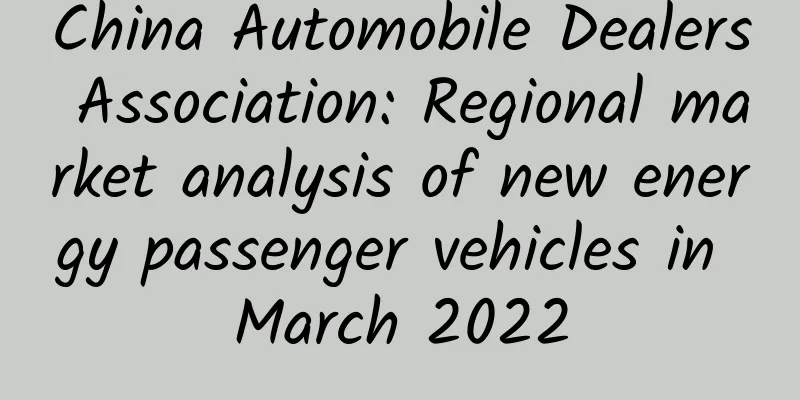China Automobile Dealers Association: Regional market analysis of new energy passenger vehicles in March 2022

|
According to the China Passenger Car Association's new energy vehicle retail data, the overall market trend continued to remain strong in March . China's traditional fuel vehicle market was sluggish in 2022 , but the epidemic and the shortage and price increase of raw materials did not affect the strong trend of new energy vehicles. This year, private demand for new energy vehicles in non-restricted areas has gradually strengthened, and new energy vehicles of traditional passenger car companies have grown strongly, especially the A00 and A0 private car markets have performed relatively strongly, and rental demand has improved. New forces of independent brands have made comprehensive efforts to strengthen, and the demand structure is becoming increasingly balanced. The performance of joint venture brand new energy vehicles needs to be improved, and BYD's plug-in hybrid has an increasingly obvious advantage over joint venture car companies, forming a new situation in which independent brands are fully ahead of joint ventures. 1. The wholesale market for new energy vehicles was relatively strong in March In March, wholesale sales of new energy passenger vehicles reached 455,000 units, a year-on-year increase of 122.4%. The trend of new energy vehicles in previous years was relatively sluggish at the beginning of the year and gradually rose. New energy vehicles started strongly from January to March 2021, and continued to strengthen from May to December. Due to the strong demand for new energy vehicles under the epidemic this year, the trend in March is still very strong. In 2021, the Chinese auto market entered a period of relatively stable growth, but new energy maintained a high growth trend. Two consecutive years of downturn laid the foundation for high growth in 2021. The growth pressure in the later period of this year continued to increase. From the base point of view, the later period of this year will continue to grow at a high level. In 2020, the sales volume of new energy passenger vehicles reached 1.17 million units, a year-on-year increase of 10%; in 2021, the sales volume of new energy passenger vehicles reached 3.31 million units, a year-on-year increase of 183%; in March 2022, the wholesale sales volume of new energy passenger vehicles reached 455,000 units, with a strong trend. From January to March 2022, the wholesale sales volume of new energy passenger vehicles reached 1.19 million units, a year-on-year increase of 145%. The price increase of electric vehicles in 2022 is relatively rational, and the new energy vehicle market remains hot. In January this year, the national subsidy standard for new energy vehicles was reduced as planned. Most companies strive to resolve the impact of the subsidy reduction through their own internal balance operations and some cost reductions in the early stage, hoping to continue the good momentum of new energy vehicle sales by making concessions. Therefore, there were few price increases before the Spring Festival, but the reduction of some companies had a greater impact on gross profit, so they adopted the approach of raising car prices to compensate for the impact of the subsidy reduction. After the price adjustment in January, domestic retail sales of new energy passenger vehicles reached 273,000 units in February 2022, a year-on-year increase of 180.9%. Orders from companies that have increased prices have recovered quickly, and the overall new energy market has not been sluggish due to the price increase of models. Since the beginning of this year, the price of power batteries has increased much faster than the industry expected due to the rising prices of raw materials such as lithium and nickel. Therefore, car companies are under great pressure after the price increase of power batteries and can only ease the cost pressure by raising prices. The impact of the current two-wheel new energy vehicle price increase is not obvious for the time being. First of all, the sales model of new energy vehicles is order sales. At present, various car companies have a large number of orders before the price increase, resulting in the digestion of previous orders in March and April, so the sales volume is not greatly affected. Secondly, the new energy plug-in hybrid has diverted the fuel vehicle market, and high oil prices have increased the advantages of new energy. Under the current high oil prices, the cost performance of new energy vehicles has been significantly improved, but the traditional vehicle market has become more difficult. The third reason is that consumers have strong rigid demand for new energy vehicles and relatively low price sensitivity, so small price changes will not significantly affect consumer demand for new energy vehicles. The fourth reason is that the order price of new energy vehicles was locked before the price increase, resulting in a locked-in price for early orders, which led to a new situation in which more consumers were rational or followed suit to rush to order. Car companies have also taken measures to regulate the order of suspected scalpers. 2. New energy vehicle retail sales grew strongly in March In 2021, the retail sales of new energy passenger vehicles reached 2.99 million, a year-on-year increase of 170%. In January-March 2022, the retail sales reached 1.13 million, a year-on-year increase of 145%, and the growth rate remained high. The domestic retail sales of new energy passenger vehicles in March 2022 far exceeded the sales trend in January, reflecting the good trend of continued strong demand. According to the retail data of the China Passenger Car Association, the retail sales of new energy passenger vehicles reached 445,000 in March, a year-on-year increase of 140%. The retail trend this year remained stable, with a small difference in sales in the first quarter compared with the fourth quarter of last year, and no rapid decline from a high level. The subsidy adjustment at the beginning of this year was relatively large, but there was no obvious change in demand for new energy vehicles after the adjustment, reflecting that market demand is not highly sensitive to price. The insurance data is not much different from the retail data of the China Passenger Car Association, and the granularity is finer, both of which reflect a good trend. 3. Usage characteristics of new energy passenger vehicles The proportion of new energy passenger vehicles in rental and leasing has gradually increased from 2017 to 2019. The proportion of pure electric vehicles in rental and leasing in 2020 has slightly decreased compared with the same period in 2019. The proportion of pure electric vehicles in rental and leasing in March 2022 is 10%, which has slightly rebounded. The proportion of plug-in hybrid vehicles in the private market has also continued to increase, and the demand for plug-in hybrid vehicles in rental and leasing has continued to decline. Most of the pure electric passenger cars of a corporate nature are used for rental purposes. There is not much market for new energy passenger cars for other purposes, or the market is gradually shrinking. This is also a reflection of the lack of market competitiveness of new energy passenger cars due to the reduction of subsidies. In the non-operating market, the individual market accounted for 78% in 2021, which was a strong performance, and the individual market accounted for 82% in 2022, further forming a high growth in the private market. Unit use continued to decline to 10%. The market for new energy passenger vehicles has been volatile recently. At the beginning of 2020, the rental electric vehicle market continued to be sluggish due to the impact of the epidemic. Among them, the rental market affected by the epidemic was hit hard and is still poor recently. In March, the proportion of passenger cars was only 10%, the lowest in recent years. 4. Regional market performance is gradually improving In the past few years, the demand for new energy passenger vehicles was strong mainly in megacities with purchase restrictions, but it has continued to decline recently. In March 2022, new energy passenger vehicles accounted for 20% of total sales in megacities, down 9 percentage points from 2021. This also shows that the sales of new energy vehicles in cities with purchase restrictions have gradually stabilized, and purchase restrictions have constrained demand. The recent county and township markets have gradually started new energy. The recent growth of new energy vehicles in the mid-to-large vehicle market reflects the good market expansion of mid-to-high-end new energy vehicles, while new energy vehicles in the county and township markets are also gradually expanding. The sales trend of new energy vehicles in large cities without purchase restrictions is not strong. 5. The performance of the new energy urban market is gradually improving The main growth of new energy vehicles in March was in large cities without purchase restrictions, such as Xi'an and Chengdu. The restricted cities such as Shenzhen, Guangzhou, and Hangzhou performed well, but the increase in Shanghai and Beijing was small. The current market growth is in large cities such as Chengdu and Hefei. The performance of cities with purchase restrictions is differentiated, and the promotion areas in special regions such as Beijing have declined significantly. From January to March 2022, there was a significant increase across the board compared to the same period in 2021. The growth in Chengdu, Foshan, Chongqing, Suzhou, Guangzhou and other cities was relatively rapid, especially Chengdu, where the increase reached 23,000 units, forming the core driving force for the increase. The Chengdu market is also a unique environment for new energy vehicles to show high growth. Products with high appearance and low use costs have great potential in the southwest region. Hangzhou and other cities with purchase restrictions such as Shenzhen and Guangzhou performed relatively well, which is also the incremental contribution of high-end models. The pure electric market share of new energy vehicles continues to increase, reaching 81% of the total in March 2022. Pure electric vehicles have a strong performance in the super-large market, accounting for 15% of pure electric vehicles, while plug-in hybrid vehicles have a relatively low overall performance in the pure electric market. Plug-in hybrid vehicles have achieved good growth in medium and small cities, while pure electric vehicles are currently relatively strong in large and medium-sized markets. 6. Regional differences in demand for pure electric vehicles The gradual start-up of the private car market has promoted the development of the industry. Although the demand in large cities with purchase restrictions is very strong this year, its share has gradually decreased, the market share of large cities with traffic restrictions has continued to rise, and the private consumption market in small and medium-sized cities has gradually recovered. The pure electric vehicle leasing market is currently gradually recovering. In 2019, leasing accounted for 32% of pure electric vehicle sales. In 2020, the proportion of leasing reached 18%. In March 2022, the performance dropped to around 10%. The proportion of rental cars in megacities has declined, while the private market is still recovering rapidly. The rental market in cities with purchase restrictions is still the core force this year. Currently, rental cars have recovered relatively quickly in large cities, and the growth in small and medium-sized cities is also relatively fast. From the performance of the main models, it reflects the improvement of the performance of the main models in large and medium-sized cities, especially the increase represented by Wuling Hongguang MINI. The increase in share in March compared with the same period was 1 percentage point in small cities and county and township markets. From the perspective of Tesla Maodou 3, the decline in share in March was mainly due to the large contribution of Shanghai in the early stage, while the market in other places was relatively good. 7. Regional demand for plug-in hybrid passenger vehicles The proportion of rental of plug-in hybrid models continues to shrink, and in 2022, the proportion dropped sharply to about 1%. The main demand for rental models is in megacities and large cities. This year, the rental of plug-in hybrid models in megacities has shrunk significantly. The incremental potential of plug-in hybrid models is large, and there is good demand in various urban markets. In recent years, the proportion of plug-in hybrid vehicles in cities without purchase restrictions has gradually increased, and BYD and Ideal are relatively strong; Wenjie M5 performed very strongly in March, surpassing some old star models. In March, plug-in hybrids strengthened compared to the same period. Restricted cities are still the main force of plug-in hybrids, and demand in non-restricted cities has not been fully and effectively promoted. Mercedes-Benz E, Changan Uni-K, Lynk & Co 09 and other restricted cities have a high degree of dependence. BYD plug-in hybrids perform well in small and medium-sized cities. 8. Regional penetration of electric passenger vehicles – March At present, the proportion of pure electric vehicles in cities with purchase restrictions has increased significantly, from 14% in 2019 to 31% in 2022, while the sales proportion of pure electric vehicles in large cities, medium-sized cities and small cities without purchase restrictions is basically the same, both at a relatively low level in 2019 and 2020. In March this year, the proportion of medium-sized cities rose to 33%, and the penetration performance in county and township markets was also strong. In 2021, the national plug-in hybrid market also reached a recent high of 6%. The penetration rate of plug-in hybrids in various parts of the country has continued to grow, especially in megacities, where the market share of plug-in hybrids reached 10% in March this year. The proportion of plug-in hybrids in the market of small and medium-sized cities has also shown a continuous increase, and the gap in plug-in hybrid penetration rates between various cities has narrowed relatively. 9. In March, companies in different regions were highly differentiated The performance of the rental markets in various regions is relatively different. The rental markets with strong performance in March this year are Chengdu, Guangzhou, Hangzhou, Chongqing, Shenzhen, Shanghai, Changsha, Haikou, Guiyang, etc., and the performance of various manufacturers in the rental markets in various regions is also quite different. In some regions, the share of local products in the local rental market is not necessarily very high. For example, in the Shenzhen market and Chongqing market, foreign brands have performed relatively well this year. The private pure electric market has relatively distinct characteristics, and the trend of high-end is extremely obvious. Tesla performed relatively well, ranking first except for Foshan. BYD performed well, ranking second except for Guangzhou and Zhengzhou. Tianjin is the Great Wall of Tianjin, and SAIC-GM-Wuling in Zhengzhou, while most other regions are high-end. New car manufacturers NIO and Xpeng Motors have performed very well. At the same time, NIO has become the second in the high-end market of pure electric vehicles, and Xpeng Motors has also performed well, while traditional car manufacturers have not performed well in private cars. BYD and Li Auto performed well in the private plug-in hybrid market, especially in BYD's main cities, where it is almost leading. Li Auto performed well in Beijing, Zhengzhou, Chongqing, etc. SAIC Passenger Cars also performed well. The plug-in hybrid performance of joint venture automakers is relatively weak, and the performance of BMW and Volkswagen Group China and Volkswagen Group China is average. 10.Beijing market trends The new energy vehicle market in Beijing was relatively stable in 2022, with sales reaching 13,000 units in March 2022. However, Beijing's sales in January 2022 were much lower than last year. New energy vehicle sales in February reached 5,400 units, and the cumulative sales from January to March increased by 28% year-on-year, which was an average performance. Since the new energy vehicle quotas became relatively tight in 2018, the Beijing new energy vehicle market in 2022 has diverged from the national trend. This is the result of the suppressed consumption caused by the rhythm of quota issuance. Beijing's new energy vehicle sales in March were relatively good, and considering the lack of indicators, the performance in March was also stable. Beijing's new energy vehicle grades are generally pragmatic, which is also a reflection of the good household demand. 11. Trends in Shanghai’s new energy market The new policy trend of the Shanghai market is in sharp contrast to that of the Beijing market, which has been extremely stable since 2019. Since March 2020, Shanghai's new energy vehicles have shown a small explosive growth feature. In March 2022, sales of new energy vehicles in Shanghai reached 21,000 units, a small decrease from 23,000 in March last year. Next month, new energy vehicles in Shanghai suffered heavy losses due to the epidemic. 12. Market trends of new energy passenger vehicles in restricted cities 13. Market trends of new energy passenger vehicles in areas with no purchase or driving restrictions Non-double-restricted cities refer to areas where there are no restrictions on the purchase and use of fuel vehicles. Since there are no restrictions on the purchase and use of traditional vehicles, the demand for new energy vehicles in these cities is real market demand. At present, the number of non-double-restricted cities is also growing rapidly. This type of city is relatively large in the country, and the sales of new energy vehicles are currently at a relatively high level. In 2022, new energy vehicles performed extremely well in non-double-restricted cities, with sales of 170,000 units in January, a strong growth rate, a growth rate of 212% in February, and sales of 233,000 units in March, a growth rate of 182%, which was higher than the growth rate in January. Overall, the cumulative sales from January to March reached 540,000 units, a year-on-year increase of 183%, showing a strong growth feature. Cities without purchase and driving restrictions, which were not affected by the policy in the early stage, have become the main force of sales and growth. All regions in the country have the characteristics of strong demand growth for new energy vehicles. Combined with the demand of cities with driving restrictions, regional market demand in 2022 will maintain strong growth. |
<<: Microsoft exec says Xbox One was made for shooters
Recommend
New Year's Day Marketing Strategy for the Wedding Photography Industry
Christmas is here, can New Year’s Day be far behi...
TVOS from the perspective of the radio and television industry: a technological chess piece to rebuild the country
TVOS1.0 is a technical move by the State Administ...
Brave New World Unreachable How difficult is it to make a VR movie?
Decades have passed, and virtual reality technolo...
How to operate an event in 7 steps for beginners
For a novice operator , how can you do a good job...
BYD: BYD's cumulative sales of new energy vehicles in the first eight months of 2022 reached 978,800 units, a year-on-year increase of 267.31%
BYD released its August sales report, which showe...
80% of affected users may abandon iPhone: Are US companies the biggest victims of the "WeChat ban"?
Trump's blockade policy against Chinese techn...
Advanced course on practical delivery of Juliang Qianchuan, delivery strategies, plans, review models and complete solutions for data anomalies
Introduction to the advanced class of Juliang Qia...
Learn this method well, you can solve 80% of Logo design problems
Addition is the most mainstream design method in ...
How much do you know about the Kitchen God who is sent to heaven during the Little New Year?
The 23rd or 24th day of the twelfth lunar month i...
Introduction to six recommended Android open source frameworks
1. Volley Project address: https://github.com/sma...
Is it possible that the speed of light is faster in some places in the universe and slower in other places?
The author or source of this article or its origi...
How to find operational guidance to leverage user growth?
As an operator , you always need to keep in mind ...
Can Tom Cruise's high-tech gloves in "Minority Report" really come true?
Senso is an experimental glove peripheral product...
Chuangqi Academy · Knowledge Payment Annual Income 300,000 Training Camp: This project has low investment, 1 mobile phone + 1 computer can start operation
Chuangqi Academy · Knowledge Payment Annual Incom...
Cloud computing war: Former Amazon employee sued for joining Google
According to foreign media reports, Amazon is sui...









